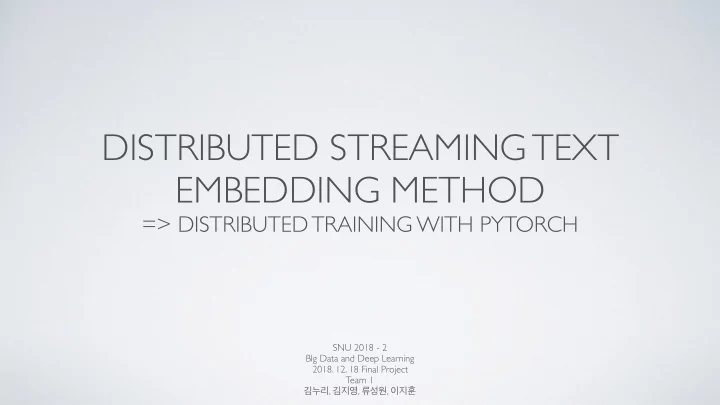

DISTRIBUTED STREAMING TEXT EMBEDDING METHOD => DISTRIBUTED TRAINING WITH PYTORCH SNU 2018 - 2 BIg Data and Deep Learning 2018. 12. 18 Final Project Team 1 김누리 , 김지영 , 류성원 , 이지훈
DISTRIBUTED STREAMING TEXT EMBEDDING FRAMEWORK • Parameter Server architecture • Nodes Crawl with CPUs • Train the model with GPU • • Parameter Server Model update • Evaluation • • Asynchronous Update
EMBEDDING MODEL FOR STREAMING TEXT • Character-wise word embedding with LSTM • Skipgram Training • Last hidden state as word embedding
PROBLEMS 1. No stable streaming datasource 2. No clear evaluation metric 3. Unstable Pytorch distributed framework
PROBLEM 1 • No stable streaming datasource • Too few machines • Crawling APIs are extremely unstable (Facebook, Youtube, Twitter) • Crawling bottleneck >> GPU bottleneck • => Check validity of distributed word embedding and our model
PROBLEM 2 • No clear evaluation metric • Word similarity task • MEN, MTurk, RW, SimLex999, WS353 • Word analogy task • Google analogy, MSR analogy • Need to train with dataset that contains all the words • Wikipedia dataset: 32GB text, 320GB when preprocessed • Takes Forever
PROBLEM 2 • Solution: PIP Loss* • Metric to measure distance between embeddings • Exploit unitary invariance property of embeddings • • The Ground truth of Skip-gram: SPPMI matrix* • • PIP Loss with SPPMI matrix can be used as evaluation metric Source: Yin, Zi, and Yuanyuan Shen. "On the dimensionality of word embedding." Advances in Neural Information Processing Systems . 2018. Levy, Omer, and Yoav Goldberg. "Neural word embedding as implicit matrix factorization." Advances in neural information processing systems . 2014.
PROBLEM 3 • Unstable Pytorch distributed framework • Data parallel
PROBLEM 3 • Pytorch 1.0 • Distributed Library • Synchronous • Asynchronous
EXPERIMENT SETUP • SGNS • 6Mb text dataset • Pytorch • Harry Potter Series • 1 process no GPU • Tokenized / lemmatized • 1 process one GPU (970) • window: 5 / ns: 10 / threshold: 3 / • 1 process 4 GPUs (970) • 4 process 4 GPUs (Ethernet) subsample: 2e-3 • Learning Rate: 1e-4 • Asynchronous • epoch: 300 • Synchronous Source: “Distributed Streaming Text Embedding Method”, Sungwon Lyu, Jeeyung Kim, Noori Kim, Jihoon Lee, Sungzoon Cho, Korea Data Mining Society 2018 Fall Conference, Special Session
EXPERIMENT RESULT 1 • Embedding size: 200 Average time • Batch size: 1024 Throughput Best PIP loss per epoch 1process 34.10 98,212.7 123.6 1 GPU 1process 25.37 132,060.5 129.6 4 GPUs Cluster 394.27 8,494.3 ? Source: “Distributed Streaming Text Embedding Method”, Sungwon Lyu, Jeeyung Kim, Noori Kim, Jihoon Lee, Sungzoon Cho, Korea Data Mining Society 2018 Fall Conference, Special Session
EXPERIMENT RESULT 2 • Embedding size: 200 Average time Throughput Best PIP loss • Batch size: 8192 per epoch 1process 28.6 117,099.8 129.3 1 GPU 1process 24.1 138,964.9 - 4 GPUs Cluster 52.79 63,441 193.6 (Sync) Cluster 46.5 72,022.6 ? (Async)
EXPERIMENT RESULT 3 • Embedding size: 50 Average time • Batch size: 1024 Throughput Best PIP loss per epoch 1process 21.6 155,048.8 14.52 1 GPU 1process 24.08 139,080.3 15.44 4 GPUs Cluster 93.81 35,700.4 44.21
EXPERIMENT RESULT 4 • Embedding size: 50 Average time • Batch size: 8192 Throughput Best PIP loss per epoch 1process 29.32 114,224.2 15.19 1 GPU 1process 21.28 157,380.3 - 4 GPUs Cluster 16.93 197,817.7 44.12
RESULT SUMMARY model node sync gpu embedding batch time/epoch lowest PIP loss sgns 4 async 4 200 8192 * 4 46.5 X sgns 4 sync 4 200 8192 * 4 52.79 193.6 sgns 4 sync 4 200 1024 * 4 394 X sgns 4 sync 4 50 8192 * 4 16.93 44.12 sgns 4 sync 4 50 1024 * 4 93.81 44.21 - sgns 1 1 200 8192 28.6 129.3 - sgns 1 1 200 1024 34.1 123.6 - sgns 1 1 50 8192 29 15.1885 - sgns 1 1 50 1024 21.6 14.52 - sgns 1 4 200 8192 * 4 24.1 ing - sgns 1 4 200 1024 * 4 25.37 129.6 - sgns 1 4 50 8192 * 4 21.28 ing - sgns 1 4 50 1024 * 4 24.08 15.44 - rnn 1 1 200 1024 1133.9 1.11
CONCLUSION • Single node is usually better when cluster is not big enough • Less communication (more batch size, less weights) leads to faster training • The quality of the word embedding is affected by batch-size (smaller seems better) • Therefore, sparse word embedding is not appropriate for distributed training
FUTURE WORK • Do experiment with dense model • Compare with Tensorflow / with PS architecture • Try Ring all-reduce • Find way to minimize the communication
Recommend
More recommend